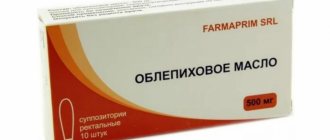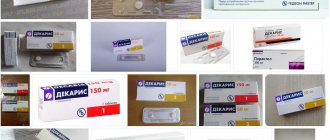Release form and composition
The drug Amol is available in two dosage forms - in the form of lozenges for resorption and an alcohol solution intended for both oral administration and topical use. Lozenges are available in boxes, and the solution is available in bottles of 50, 100, 150 or 200 ml.
One Amol lozenge contains the following components:
- Vitamin C – 30 mg;
- Menthol – 10 mg;
- Lemon oil – 7.650 mg;
- Peppermint oil – 3.222 mg;
- Cinnamon oil – 3.222 mg;
- Lavender oil – 3.222 mg;
- Clove oil – 1.342 mg;
- Citronella oil – 1.342 mg.
100 ml of Amol alcohol solution contains the following components:
- Menthol – 17.23 g;
- Lemon oil – 5.7 g;
- Peppermint oil – 2.4 g;
- Cinnamon oil – 2.4 g;
- Lavender oil – 2.4 g;
- Clove oil – 1 g;
- Indian lemon balm oil – 1 g.
Pharmacological action of Amol
Amol is a herbal preparation that tends to increase the body’s resistance, providing a disinfectant, anti-inflammatory, local irritant, and analgesic effect.
The composition of the drug Amol includes vitamin C, menthol, clove oil, cinnamon oil, mint oil, lavender oil, lemon oil, and citranella oil. In addition, the alcohol solution additionally contains Indian lemon balm.
It has been noted that the medicine effectively relieves inflammation of the throat, eliminates cold symptoms and pain arising from joint diseases.
Indications for use of Amol
According to the instructions for Amol, this drug in the form of lozenges is intended for the treatment of various colds, which are accompanied by the following main symptoms:
- Pain in the throat;
- Bronchitis;
- Nasal congestion;
- Runny nose;
- Cough;
- Hoarseness.
In accordance with the instructions for Amol, a solution of this drug is used in the following cases:
- Increased fatigue and overwork;
- Dizziness;
- General malaise;
- Circulatory disorders due to various diseases of the nervous system;
- Colds;
- Cardialgia;
- Migraine;
- Asthenia;
- Heaviness in the stomach;
- Insomnia.
The use of Amol in the form of a solution is also prescribed for headaches of various types. The drug helps to get rid of tension-type headaches, as well as chronic post-traumatic, vascular and drug-induced headaches.
Local rubbing with Amol alcohol solution is carried out to eliminate pain caused by the following diseases:
- Myalgia;
- Neuralgia;
- Rheumatism;
- Sciatica;
- Astralgia.
Instructions for use AMOCLAV-1000 (AMOCLAV-1000)
Before starting treatment with Amoklav-1000, it is necessary to collect a detailed history regarding previous hypersensitivity reactions to penicillins, cephalosporins or other beta-lactam antibiotics (see sections “Contraindications” and “Side Effects”).
Serious, sometimes fatal, hypersensitivity reactions (anaphylactoid reactions) to penicillins have been described. The risk of such reactions is highest in patients with a history of hypersensitivity reactions to penicillins and in individuals with atopy. If an allergic reaction occurs, treatment with amoxicillin/clavulanic acid should be discontinued and alternative therapy should be initiated.
If the infection is confirmed to be due to amoxicillin-susceptible organisms, a switch from amoxicillin/clavulanic acid therapy to amoxicillin therapy should be considered in accordance with official guidelines.
Amoklav-1000 tablets are not suitable for use in cases where there is a high risk that the suspected pathogens have reduced sensitivity or resistance to beta-lactams, which is not mediated by beta-lactamases inhibited by clavulanic acid. These dosage forms should not be used in the treatment of infections caused by penicillin-resistant Streptococcus pneumoniae.
In patients with impaired renal function or when taking high doses of the drug, seizures may occur (see section "Side effects").
The use of amoxicillin/clavulanic acid is not recommended for suspected infectious mononucleosis, since such patients experience a morbilliform rash after taking amoxicillin.
The combined use of allopurinol and amoxicillin increases the risk of allergic skin reactions.
Long-term treatment may lead to excessive proliferation of insensitive microorganisms.
The appearance of pustules on erythematous areas of the skin with fever at the beginning of treatment may be a symptom of acute generalized exanthematous pustulosis. The occurrence of this adverse reaction requires discontinuation of the drug and is a contraindication to further use of amoxicillin. The amoxicillin/clavulanic acid combination should be used with caution in patients with symptoms of liver failure (see sections “Dosage regimen”, “Contraindications”).
Adverse liver events have been observed primarily in men and elderly patients and may be associated with long-term therapy. These adverse events are very rarely observed in children. Signs and symptoms of liver dysfunction usually occur during or immediately after completion of therapy, but in some cases may not appear until several weeks after completion of therapy. As a rule, they are reversible. Adverse effects from the liver can be severe, and in extremely rare cases there have been reports of death. In almost all cases, these were persons with serious comorbidities or persons receiving concomitantly potentially hepatotoxic drugs.
Antibiotic-associated colitis has been reported with virtually all antibacterial agents. This adverse reaction can vary in severity from mild to life-threatening (see section "Side effects"). Therefore, this diagnosis should be considered in patients who develop diarrhea during treatment or after administration of any antibiotics. If antibiotic-associated colitis occurs, the drug should be discontinued immediately. The patient should consult a doctor who will prescribe appropriate treatment. In such a situation, the use of drugs that inhibit peristalsis is contraindicated.
During long-term therapy with Amoclav-1000, it is recommended to periodically monitor renal, liver and hematopoietic function.
In patients receiving a combination of amoxicillin and clavulanic acid, prolongation of prothrombin time has been observed in rare cases. When co-prescribing a combination of amoxicillin and clavulanic acid with anticoagulants, appropriate monitoring should be carried out. To maintain the desired level of anticoagulation, dose adjustment of the anticoagulant may be necessary (see sections “Drug Interactions” and “Side Effects”).
In patients with impaired renal function, the dose of Amoclav-1000 should be adjusted according to the degree of impairment (see section "Dosage regimen").
In patients with reduced diuresis, the development of crystalluria has been reported in very rare cases, mainly with parenteral use of the drug. While taking high doses of amoxicillin, it is recommended to drink enough fluids and maintain adequate diuresis to reduce the chance of amoxicillin crystal formation. In patients with urinary catheters, catheter patency should be checked regularly (see section "Overdose").
During treatment with amoxicillin, if tests for the presence of glucose in urine are necessary, enzymatic methods for determining glucose oxidase should be used due to the possibility of obtaining a false positive result when using non-enzymatic methods. The presence of clavulanic acid in the drug may cause nonspecific binding of IgG and albumin to red blood cell membranes, which may lead to a false-positive Coombs test result.
Patients taking the amoxicillin/clavulanic acid combination may experience a false-positive test result for Aspergillus infection when using the Platelia Aspergillus EIA tests. Cross-reactions between the Platelia Aspergillus EIA test and non-Aspergillus polysaccharides and polyfuranoses have been reported. Therefore, positive test results in patients taking the combination of amoxicillin/clavulanic acid should be interpreted with caution and confirmed by other diagnostic methods.
Impact on the ability to drive vehicles and machinery
No special studies have been conducted, but adverse reactions may occur (allergic reactions, dizziness, convulsions), which may affect the ability to drive vehicles and other mechanisms.
Contraindications
According to the instructions for Amol, this drug in the form of lozenges is not recommended for children under 4 years of age. Also, this dosage form should not be used by older children who cannot dissolve the lozenge on their own.
The use of Amol is contraindicated in cases of individual intolerance to one or more components included in the drug. Bandages soaked in Amol solution are not recommended to be applied to the face of newborn children, especially the child’s nose area. It should also be noted that it is necessary to avoid getting the solution into the eyes.
Storage conditions, price and analogues
The drug does not require special storage conditions and retains its medicinal properties for about 2 years. This shelf life is provided for in the instructions for use of Amola. It is difficult to determine the price of medicine in pharmacies. This product is produced and sold in Poland. It is almost impossible to purchase it in Russian pharmacy chains. Usually, medicine is purchased either while traveling to Poland, or ordered online from foreign pharmacies that deliver medicine to Russia. The price of the medicine is about 17 zlotys (approximately 272 rubles).
People often wonder if there is an analogue of this medicine among Russian drugs. "Amol" has a special composition consisting of essential oils of many plants. The uniqueness of this product lies in the combination of the healing properties of the ingredients. Unfortunately, a similar drug is not available in Russia.
Only Amol, made in Germany, can serve as a complete analogue. But it also cannot be found on wide sale. It is possible to order German “Amol” from online pharmacies that import medications from Germany. The price of medicine on such resources is quite high, about 3,000 rubles, since delivery from abroad is expensive.
Directions for use and dosage of Amol
The use of Amol for symptoms of colds involves a dosage of 1 lozenge at a time. Lozenges must be dissolved until they are completely dissolved in the mouth.
The drug solution, which is taken orally, is usually consumed in two forms: it is mixed with liquid or dripped onto sugar in pieces. In the first case, 10-15 drops of Amol solution are added to 100 ml of plain water or tea. The same dosage of the drug is observed when taken with sugar.
Hot inhalations are also carried out using this medicine in the form of a solution. They help completely eliminate the symptoms of colds. To do this, add a solution of 1 teaspoon to 250 ml of hot water.
As for the external local use of Amol, this drug in the form of a solution is diluted with water in a ratio of 1 to 3. The resulting liquid is used to rub painful areas of the body. Often they are also covered with a bandage soaked in a solution.
What diseases does it help with?
The drug has a therapeutic effect on a fairly wide range of diseases. First of all, it helps against inflammation caused by bacteria and viruses. Instructions for use of Amola recommend taking it for the following ailments:
- colds and runny nose of bacterial and viral origin;
- diseases of the upper respiratory tract, accompanied by cough and sore throat;
- rheumatism;
- pain in muscles and joints;
- lumbar acute pain (lumbago);
- neuralgia of the facial nerve;
- pain in the spine;
- headache;
- insomnia;
- general weakness.
The drug can be taken as an adaptogen during sudden changes in lifestyle and climate, as well as during fatigue.
Reviews about the medicine
Users note that the lozenges and solution cause virtually no side effects if you follow the instructions for using Amola. Reviews about the medicine are mostly positive. Many patients report that if they take this medication at the initial symptoms of a cold, their cough, runny nose, and sore throat disappear and never return. Elderly people write that compresses with tincture effectively relieve joint pain due to rheumatism.
Some users add a few drops of tincture to tea daily for preventive purposes. This helps them feel more energetic, get sick less, and better adapt to changes in the external environment.
Patients consider the only disadvantage of the drug to be its inaccessibility. As a rule, people buy Amol during trips abroad. But those who have taken the medicine note its effectiveness.
When will the effect occur?
The effect of using Almag 01, as a rule, does not occur immediately. This largely depends on the disease you want to treat. The device must be used regularly. The course, depending on the disease and its nature, can range from 10 to 20 procedures; its duration must be discussed with a doctor.
Usually the effect can be felt after several treatments. But in some cases it will be necessary to undergo a full course of treatment, and sometimes a repeated course of treatment is necessary.
Safety precautions when working with the device
- Before using the device, be sure to carefully read the instruction manual.
- Inspect the device. Make sure that the housing, inductors and cables are not damaged. If there is any damage, the Almag 01 device must not be used under any circumstances.
- The device can only be connected to a working electrical outlet. Sockets with an operating voltage of ~220V (-10%, +10%) or ~230V (-10%, +6%) and a frequency of 50 Hz are suitable. Make sure that the network cable is not stretched to the limit when connecting.
- Protect the device from dampness, shock and shock. When treating the device with a disinfectant solution, avoid getting moisture inside the inductor coils and the electronic unit.
Precautions for therapeutic effects
- The duration of the first procedure is 10 minutes or even less.
- When treating two zones, the total exposure time is no more than 30 minutes.
- If an effect on the cervicothoracic spine is necessary, the duration of the first three procedures is no more than 10 minutes.
- Direct effects on the heart and brain are prohibited.
The device cannot:
- lift and carry by the power cord;
- place next to magnetic storage media and magnetically sensitive devices (audio, video equipment and other similar devices).
How to check the functionality of the Almag 01 device?
The delivery set includes a special device - a magnetic field indicator. It is intended to test the functionality of the Almag 01 device. It's very easy to use:
- turn on the device;
- place the indicator on the working surface of the coil;
- Wait until the indicator blinks or vibrates (depending on which model is included in your kit).
If the indicator does not react in any way when the device is turned on, then something is wrong with the device.





